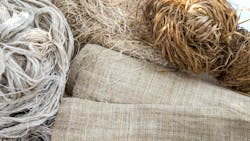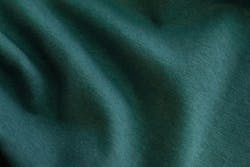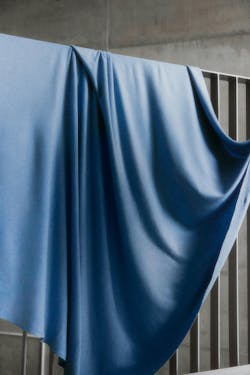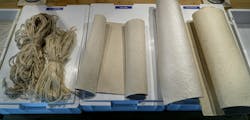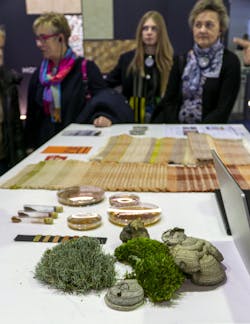Commercial Materials Industry Moves Closer to Scalable Biomaterials Solutions
Any time we discuss biomaterials in commercial interiors, some context and clarification is required.
This is the theme that dominated sustainability discussions at the Heimtextil textiles and interiors fair in early January, Frankfurt, Germany. Heimtextil is the design world’s first major trend event every year, kicking off a series of shows throughout Europe that include Domotex (flooring, Hannover, Germany), Bau (architectural products, Munich), Maison & Objet (Paris), the Stockholm Furniture & Light Fair, and Ambiente (Frankfurt). Some of our industry’s most rabid design hounds start their year with a solid month on the road.
Susanna Björklund is a Finnish trend analyst, frequent guest speaker, and exhibit curator at many of these events. She’s also a senior lecturer and foresight specialist at the LAB University of Applied Sciences in Lahti, Finland, and a regular Heimtextil observer.
“I specialize in futures research and study societal changes and phenomena,” Björklund said, “and share my findings with my classes, and in reports for the university and with corporate furniture and interiors clients.
“My job is to look for change, especially in how we talk about and are working to address climate change. Here’s what everyone needs to understand: Everything is systemic. Everything is linked with everything, and that's why when we’re thinking about solutions we have to weigh the impacts and potential ripple effects of different possible futures.”
What Do We Mean by ‘Biomaterials’?
“Biomaterials” describes materials derived from biological sources, as well as those that incorporate biological concepts and sustainable practices. There’s an emphasis on materials made from the byproducts and waste of other processes, Björklund says, especially in food production. So, while wool and cotton are certainly biomaterials, they’re not currently going to waste, so they don’t belong in a conversation about biomaterial solutions. The same goes for leather.
Wood is another biomaterial, technically speaking, and Finland, like North America, has plenty of it. Seventy years ago we were only able to use about 50% of a harvested tree, for construction lumber, flooring, and siding. Engineered wood products like particleboard and MDF have reduced that waste factor to less than 1% of the harvested fiber, and wood from managed forests is considered an “infinitely renewable resource,” but because this is an established value chain it’s also not part of the biomaterial “solutions” conversation, according to Björklund.
There is one example of a new wood-based biomaterial, she says: Spinnova. The company converts waste-wood cellulose into fibers—through a process inspired by the way spiders spin silk—which are then used to make yarns for textiles. Spinnova uses 99% less water than cotton production.
“Spinnova is a little bit unique in that their technology is actually scalable,” Björklund explained. “This is a challenge for many, if not most, of the biomaterials out there. The resources are too scarce to achieve commercial volumes, or the processing technology is too rare, or the the costs associated with both are too high…often, it’s all of the above.”
Agoprene was one such material being talked about at the Stockholm Furniture & Light fair. It’s a bio-based replacement for cushion foam made primarily from Norwegian kelp, combined with minerals from crab shells and waste from the Norwegian paper industry. It’s 100% biodegradable and contains no harmful or petroleum-based chemicals.
“It’s a great idea, but there’s only so much Norwegian kelp to go around,” Björklund noted. We’re still a long way from having something that can compete with the volume and low costs of petroleum-based foams.
A similar problem faces bio-based leather replacements, Björklund says. “There’s a material made from pineapple leaf fibers, Piñatex, that is used in shoes, handbags, and furniture. It’s still a niche material because it’s more expensive, doesn’t wear as well, and isn’t as water-resistant as leather.”
Some producers of leather alternatives address these issues by applying a synthetic coating or finish to their materials.
“This negates the whole idea of a natural substitute,” she noted. “It’s not natural anymore if you have to put a bloody synthetic coating on it!”
‘Yes, And…’
Björklund also takes issue with the language surrounding bio-based alternatives.
“There’s a lot of talk about these materials as replacements, or substitutes for the originals. We can’t think about them this way. Let’s be real: Leather, as we know it now, has a six-thousand-year head start; polyurethane foam has a hundred-year head start,” she explained. “We need to give these new materials time to get established. And we need to stop pretending they’ll be able to step right up and ‘replace’ these other materials.
“This means changing our quick-change mindset. It has to be ‘yes, and…’ instead of ‘out with the old, in with the new.’ It’s going to take loads of different materials to make a dent in our consumption of leather, or furniture foam, or synthetic textiles. And we have to face the fact that they may never be as cheap as what we have now, especially petroleum-based products.”
Past Perfect
Björklund says we should also be ready to adjust our concept of “luxury” to embrace imperfection.
“Imperfection will BE the new luxury. New bio-based materials won’t have the same properties as the originals, so we’re just going to have to adapt. Dyeing textiles for those rich and vibrant colors is terrible for the environment, because of the toxic chemicals required and the amount of water used.
“People are experimenting with dyeing textiles and ceramics with specific bacteria that produce different colors without the damage done by current methods. The problem is, sometimes those colors don’t last. They fade. But so does the blue in our jeans, and no one seems to have a problem with that. We’ll adapt,” Björklund concluded.
About the Author

Kenn Busch
Contributing Editor
Kenn Busch is a longtime journalist, educator and public speaker dedicated to bridging the knowledge gap between materials, sustainability, and furniture and interior architecture. He is the founder of MateralIntelligence.com and ClimatePositiveNOW.org, two major resources for design and manufacturer specifiers.
